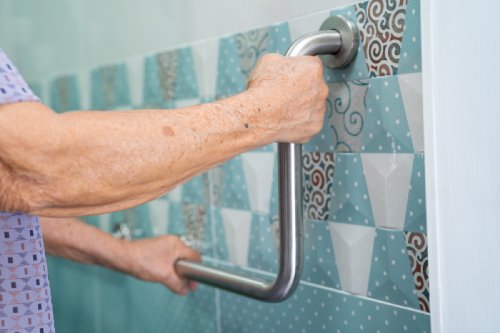
A serious injury as a result of falling is one of the top reasons seniors are unable to continue living in their home. Too often a home safety assessment is never conducted and hazards are not apparent until it is too late.
The good news is that many trip and fall hazards are simple fixes and can be preventable by following simple fall prevention guidelines. Let’s look at the 8 most common causes of falls among seniors, and how to address each of them.
Stairs:
Though the best course of action is having a bedroom on the ground floor of a home before moving in, there are a few ways to decrease the risk of falling on stairs should they be unavoidable.
Install a Residential Stairlift:
A stairlift is a quick install that isn’t overly expensive and takes standing out of the equation. For seniors with balance issues, being able to sit while going up stairs is crucial. A walker at the top and bottom of the stairs can help with standing up, and lower the risk of falling when entering and exiting the chair.
Reinforce Railings:
A wobbly handrail does no favors for preventing falls. Make sure railings are snug and don’t show signs of damage. Seniors should be able to comfortably wrap their entire hand around the railing. If the railing is too round or any defects are found, schedule a fix as soon as possible and take extra care in use.
Add Non-Slip Treads to Stairs:
If the staircase is not carpeted, non-slip treads should be installed on each stair to help with grip.
Add Lights:
Being able to see each step is important to prevent a misstep which leads to a trip and fall. Adding small lights at the side of each step can help guide you up the stairs and increase depth perception.
Rippled Carpet & Freestanding Rugs:
Uneven carpets can snag a senior’s foot sending them to the ground. To prevent a fall, all carpet should be free of bulges and ripples. For any rugs, they should be secured to the floor at each corner to prevent slipping.
Narrow Walking Space and Clutter:
Not only does a narrow walking space make it hard to navigate. It may not leave enough room for a wheelchair or walker to go through. This could prevent using them even when needed. A narrow space also opens up the opportunity for any clutter to quickly enter the walking path and leads to more sideways twisting which can knock off your balance. Pathways should be widened and free of clutter to allow easy walking. This may require removing furniture or other obstructions to make adequate space.
Shoes:
Having shoes which fit and offer adequate traction goes a long way in keeping balance. Make sure shoes are snug and tied before moving. If the laces keep coming untied , consider a pair which uses elastic or velcro straps instead of laces. Replace your shoes whenever the traction is worn.
Lighting:
All living spaces should be evenly lit. Light switches should be easy to access or motion lights should be installed. For nighttime use, nightlights can be helpful but using a bedside lamp and waiting a moment before getting out of bed offers added protection.
Add Bathroom Safety Accessories:
Many homes are outfitted with shower tubs. Though great for the occasional bath, or for when raising children, these showers pose a great risk for falling. Having to lift one foot at a time and step into the shower can throw off balance and worse yet, without a slip mat standing water in the shower could lead to a fall.
If possible, a walk in shower should be installed with a corner seat and hand grabs. At the very least, hand grabs should be installed in any shower and a bath seat should remain in the tub. Having the ability to sit while washing reduces risk and hand grabs help with entering and exiting the shower.
For using the toilet, raised seats can help reduce the distance and effort needed to sit and stand. Having grab bars at the side of the toilet can limit the chance of falling when standing up.
Read our previous article where we talk about 10 must have bathroom accessories for an aging place.
Pets:
Having a cat or dog can provide joy and companionship for seniors. However, our furry friends don’t always know when they are in the way, and can lie down in front of us, serving as a hazard. When excited, they may run up from behind and startle or bump into us, causing a fall. Additionally their toys which could end up in our pathways.
For seniors with pets, it’s important to check for them before standing up. Toys should be picked up and feeding bowls raised to prevent bending over.
Dog owners should consider training to instill proper behavior and prevent tugging when walking. Even with a well behaved dog, be aware of possible distractions which could send your dog running.
Cords:
Seniors should never try to step over cords, as doing so can quickly lead to a fall. When possible cords should be placed behind furniture. If the cord is not long enough, an extension should be laid, and secured along the wall, or underneath furniture, but never in the pathway of walking.
Get Help With Aging In Place
Preventing falls goes a long way in helping seniors age in place, but health is only one aspect of successful aging in place. Blakeford’s LiveWell program goes above and beyond basic care needs, to help seniors with a financial plan, and long-term care plan to ensure they can remain in their home for as long as possible. Each plan is personalized and LiveWell members join a robust community that is empowered to feel strong, safe, and independent.

